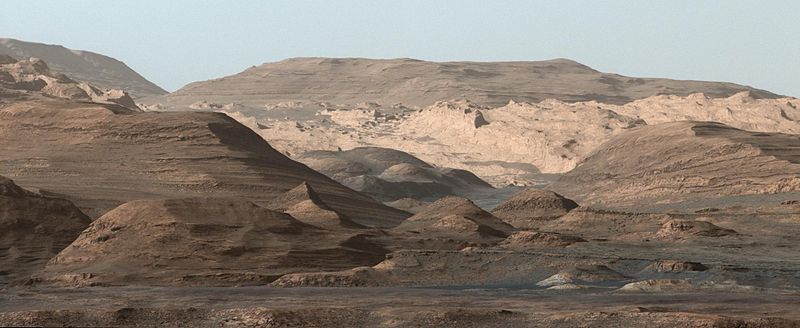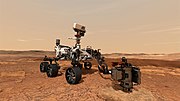Curiosity(rover)
| Curiosity | |
|---|---|
| Part ofMars Science Laboratory | |
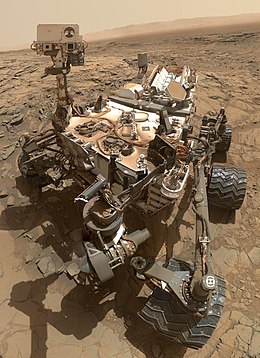 Self-portraitbyCuriosityat the foot ofMount Sharpin October 2015 | |
| Type | Mars rover |
| Owner | NASA |
| Manufacturer | Jet Propulsion Laboratory |
| Specifications | |
| Dimensions | 2.9 m × 2.7 m × 2.2 m (9 ft 6 in × 8 ft 10 in × 7 ft 3 in) |
| Dry mass | 899 kilograms (1,982 lb) |
| Communication | |
| Power | MMRTG:~100 W (0.13 hp) |
| Rocket | Atlas V 541 |
| Instruments | |
| History | |
| Launched |
|
| Deployed |
|
| Location | Gale crater,Mars |
| Traveled | 31.99 km (19.88 mi) on Mars as of 24 June 2024[update][1] |
| NASAMars rovers | |
Curiosityis a car-sizedMars roverexploringGale craterandMount SharponMarsas part ofNASA'sMars Science Laboratory(MSL) mission.[2]Curiositywas launched fromCape Canaveral(CCAFS) on November 26, 2011, at 15:02:00UTCand landed onAeolis Palusinside Gale crater on Mars on August 6, 2012, 05:17:57 UTC.[3][4][5]TheBradbury Landingsite was less than 2.4 km (1.5 mi) from the center of the rover's touchdown target after a 560 million km (350 million mi) journey.[6][7]
Missiongoalsinclude an investigation of the Martianclimateandgeology,assessment of whether the selected field site inside Gale has ever offeredenvironmental conditionsfavorable formicrobial life(including investigation of therole of water), andplanetary habitabilitystudies in preparation forhuman exploration.[8][9]
In December 2012,Curiosity'stwo-year mission was extended indefinitely,[10]and on August 5, 2017, NASA celebrated the fifth anniversary of theCuriosityrover landing.[11][12]On August 6, 2022, a detailed overview of accomplishments by theCuriosityrover for the last ten years was reported.[13]The rover is still operational, and as of 5 July 2024,Curiosityhas been active on Mars for 4235sols(4351total days;11 years, 334 days) since its landing (seecurrent status).
The NASA/JPL Mars Science Laboratory/CuriosityProject Team was awarded the 2012Robert J. Collier Trophyby theNational Aeronautic Association"In recognition of the extraordinary achievements of successfully landingCuriosityon Mars, advancing the nation's technological and engineering capabilities, and significantly improving humanity's understanding of ancient Martian habitable environments. "[14]Curiosity'srover design serves as the basis for NASA's 2021Perseverancemission,which carries different scientific instruments.
Mission[edit]
Goals and objectives[edit]
As established by theMars Exploration Program,the main scientific goals of the MSL mission are to help determine whether Mars could ever have supportedlife,as well as determining therole of water,and to study theclimateandgeology of Mars.[8][9]The mission results will also help prepare for human exploration.[9]To contribute to these goals, MSL has eight main scientific objectives:[15]
- Biological
- Determine the nature and inventory oforganic carbon compounds
- Investigate the chemicalbuilding blocks of life(carbon, hydrogen, nitrogen, oxygen, phosphorus, andsulfur)
- Identify features that may represent the effects of biological processes (biosignaturesandbiomolecules)
- Geological and geochemical
- Investigate the chemical,isotopic,and mineralogical composition of the Martian surface and near-surface geological materials
- Interpret the processes that have formed andmodified rocks and soils
- Planetary process
- Assess long-timescale (i.e., 4-billion-year)Martian atmosphericevolution processes
- Determine present state, distribution, andcycling of waterandcarbon dioxide
- Surface radiation
- Characterize the broad spectrum of surface radiation, includinggalactic and cosmic radiation,solar proton eventsandsecondary neutrons.As part of its exploration, it also measured the radiation exposure in the interior of the spacecraft as it traveled to Mars, and it is continuing radiation measurements as it explores the surface of Mars. This data would be important for a futurecrewed mission.[16]
About one year into the surface mission, and having assessed that ancient Mars could have been hospitable to microbial life, the MSL mission objectives evolved to developing predictive models for the preservation process oforganic compoundsandbiomolecules;a branch of paleontology calledtaphonomy.[17]The region it is set to explore has been compared to theFour Cornersregion of theNorth American west.[18]
Name[edit]
ANASApanel selected the nameCuriosityfollowing a nationwide student contest that attracted more than 9,000 proposals via the Internet and mail. A sixth-grade student fromKansas,12-year-old Clara Ma from Sunflower Elementary School inLenexa, Kansas,submitted the winning entry. As her prize, Ma won a trip toNASA'sJet Propulsion Laboratory(JPL) inPasadena, California,where she signed her name directly onto the rover as it was being assembled.[19]
Ma wrote in her winning essay:
Curiosity is an everlasting flame that burns in everyone's mind. It makes me get out of bed in the morning and wonder what surprises life will throw at me that day. Curiosity is such a powerful force. Without it, we wouldn't be who we are today. Curiosity is the passion that drives us through our everyday lives. We have become explorers and scientists with our need to ask questions and to wonder.[19]
Cost[edit]
Adjusted for inflation,Curiosityhas a life-cycle cost of US$3.2 billion in 2020 dollars. By comparison, the 2021Perseverancerover has a life-cycle cost of US$2.9 billion.[20]
Rover and lander specifications[edit]

Curiosityis 2.9 m (9 ft 6 in) long by 2.7 m (8 ft 10 in) wide by 2.2 m (7 ft 3 in) high,[21]larger than Mars Exploration Rovers, which are 1.5 m (4 ft 11 in) long and have a mass of 174 kg (384 lb) including 6.8 kg (15 lb) of scientific instruments.[22][23][24]In comparison toPancamon the Mars Exploration Rovers, the MastCam-34 has 1.25× higherspatial resolutionand the MastCam-100 has 3.67× higher spatial resolution.[25]
Curiosityhas an advancedpayloadof scientific equipment on Mars.[26]It is the fourth NASA robotic rover sent to Mars since 1996. Previous successful Mars rovers areSojournerfrom theMars Pathfindermission (1997), andSpirit(2004–2010) andOpportunity(2004–2018) rovers from theMars Exploration Rovermission.
Curiositycomprised 23% of the mass of the 3,893 kg (8,583 lb) spacecraft at launch. The remaining mass was discarded in the process of transport and landing.
- Dimensions:Curiosityhas a mass of 899 kg (1,982 lb) including 80 kg (180 lb) of scientific instruments.[22]The rover is 2.9 m (9 ft 6 in) long by 2.7 m (8 ft 10 in) wide by 2.2 m (7 ft 3 in) in height.[21]
The main box-like chassis forms the Warm Electronics Box (WEB).[27]: 52
- Power source:Curiosityis powered by aradioisotope thermoelectric generator(RTG), like the successfulViking 1andViking 2Mars landers in 1976.[28][29]
- Radioisotope power systems (RPSs) are generators that produce electricity from the decay ofradioactive isotopes,such asplutonium-238,which is a non-fissileisotope of plutonium. Heat given off by the decay of this isotope generates electrical power usingthermocouples,providing consistent power during all seasons and through the day and night.Waste heatis also used via pipes to warm systems, freeing electrical power for the operation of the vehicle and instruments.[28][29]Curiosity'sRTG is fueled by 4.8 kg (11 lb) ofplutonium-238 dioxidesupplied by theU.S. Department of Energy.[30]
- Curiosity's RTG is theMulti-Mission Radioisotope Thermoelectric Generator(MMRTG), designed and built byRocketdyneandTeledyne Energy Systemsunder contract to theU.S. Department of Energy,[31]and fueled and tested by theIdaho National Laboratory.[32]Based on legacy RTG technology, it represents a more flexible and compact development step,[33]and is designed to produce 110 watts of electrical power and about 2,000 watts of thermal power at the start of the mission.[28][29]The MMRTG produces less power over time as its plutonium fuel decays: at its minimum lifetime of 14 years, electrical power output is down to 100 watts.[34][35]The power source generates 9 MJ (2.5 kWh) of electrical energy each day, much more than the solar panels of the now retiredMars Exploration Rovers,which generated about 2.1 MJ (0.58 kWh) each day. The electrical output from the MMRTG charges two rechargeablelithium-ion batteries.This enables the power subsystem to meet peak power demands of rover activities when the demand temporarily exceeds the generator's steady output level. Each battery has a capacity of about 42ampere hours.
- Heat rejection system:The temperatures at the landing site vary seasonally and the thermal system warms the rover as needed. The thermal system does so in several ways: passively, through the dissipation to internal components; by electrical heaters strategically placed on key components; and by using the rover heat rejection system (HRS).[27]It uses fluid pumped through 60 m (200 ft) of tubing in the rover body so that sensitive components are kept at optimal temperatures.[36]The fluid loop serves the additional purpose of rejecting heat when the rover has become too warm, and it can also gather waste heat from the power source by pumping fluid through two heat exchangers that are mounted alongside the RTG. The HRS also has the ability to cool components if necessary.[36]
- Computers:The two identical on-board rover computers, called Rover Compute Element (RCE) containradiation hardenedmemory to tolerate the extreme radiation from space and to safeguard against power-off cycles. The computers run theVxWorksreal-time operating system(RTOS). Each computer's memory includes 256kilobytes(kB) ofEEPROM,256megabytes(MB) ofdynamic random-access memory(DRAM), and 2gigabytes(GB) offlash memory.[37]For comparison, the Mars Exploration Rovers used 3 MB of EEPROM, 128 MB of DRAM, and 256 MB of flash memory.[38]
- The RCE computers use theRAD750Central processing unit(CPU), which is a successor to theRAD6000CPU of the Mars Exploration Rovers.[39][40]The IBM RAD750 CPU, a radiation-hardened version of thePowerPC 750,can execute up to 400Million instructions per second(MIPS), while the RAD6000 CPU is capable of up to only 35 MIPS.[41][42]Of the two on-board computers, one is configured as backup and will take over in the event of problems with the main computer.[37]On February 28, 2013, NASA was forced to switch to the backup computer due to a problem with the active computer's flash memory, which resulted in the computer continuously rebooting in a loop. The backup computer was turned on insafe modeand subsequently returned to active status on March 4, 2013.[43]The same problem happened in late March, resuming full operations on March 25, 2013.[44]
- The rover has aninertial measurement unit(IMU) that provides 3-axis information on its position, which is used in rover navigation.[37]The rover's computers are constantly self-monitoring to keep the rover operational, such as by regulating the rover's temperature.[37]Activities such as taking pictures, driving, and operating the instruments are performed in a command sequence that is sent from the flight team to the rover.[37]The rover installed its full surface operations software after the landing because its computers did not have sufficient main memory available during flight. The new software essentially replaced the flight software.[7]
- The rover has four processors. One of them is aSPARCprocessorthat runs the rover's thrusters and descent-stage motors as it descended through theMartian atmosphere.Two others arePowerPCprocessors: the main processor, which handles nearly all of the rover's ground functions, and that processor's backup. The fourth one, anotherSPARCprocessor, commands the rover's movement and is part of itsmotor controllerbox. All four processors aresingle core.[45]
Communications[edit]

- Communications:Curiosityis equipped with significant telecommunication redundancy by several means: anX bandtransmitter and receiverthat can communicate directly with Earth, and anUltra high frequency(UHF)Electra-Litesoftware-defined radiofor communicating with Mars orbiters.[27]Communication with orbiters is the main path for data return to Earth, since the orbiters have both more power and larger antennas than the lander, allowing for faster transmission speeds.[27]Telecommunication included a small deep space transponder on the descent stage and a solid-state power amplifier on the rover forX-band.The rover also has two UHF radios,[27]the signals of which orbiting relay satellites are capable of relaying back to Earth. Signals between Earth and Mars take an average of 14 minutes, 6 seconds.[46]Curiositycan communicate with Earth directly at speeds up to 32 kbit/s, but the bulk of the data transfer is being relayed through theMars Reconnaissance OrbiterandOdyssey orbiter.Data transfer speeds betweenCuriosityand each orbiter may reach 2000 kbit/s and 256 kbit/s, respectively, but each orbiter is able to communicate withCuriosityfor only about eight minutes per day (0.56% of the time).[47]Communication from and toCuriosityrelies on internationally agreed space datacommunications protocolsas defined by theConsultative Committee for Space Data Systems.[48]
- Jet Propulsion Laboratory(JPL) is the central data distribution hub where selected data products are provided to remote science operations sites as needed. JPL is also the central hub for the uplink process, though participants are distributed at their respective home institutions.[27]At landing, telemetry was monitored by three orbiters, depending on their dynamic location: the2001 Mars Odyssey,Mars Reconnaissance Orbiterand ESA'sMars Expresssatellite.[49]As of February 2019, theMAVENorbiter is being positioned to serve as a relay orbiter while continuing its science mission.[50]
Mobility systems[edit]

- Mobility systems:Curiosityis equipped with six 50 cm (20 in) diameter wheels in arocker-bogiesuspension. These are scaled versions of those used onMars Exploration Rovers(MER).[27]The suspension system also served as landing gear for the vehicle, unlike its smaller predecessors.[51][52]Each wheel has cleats and is independently actuated and geared, providing for climbing in soft sand and scrambling over rocks. Each front and rear wheel can be independently steered, allowing the vehicle to turn in place as well as execute arcing turns.[27]Each wheel has a pattern that helps it maintain traction but also leaves patterned tracks in the sandy surface of Mars. That pattern is used by on-board cameras to estimate the distance traveled. The pattern itself isMorse codefor "JPL" (·--- ·--· ·-··).[53]The rover is capable of climbing sand dunes with slopes up to 12.5°.[54]Based on thecenter of mass,the vehicle can withstand a tilt of at least 50° in any direction without overturning, but automatic sensors limit the rover from exceeding 30° tilts.[27]After six years of use, the wheels are visibly worn with punctures and tears.[55]
- Curiositycan roll over obstacles approaching 65 cm (26 in) in height,[26]and it has a ground clearance of 60 cm (24 in).[56]Based on variables including power levels, terrain difficulty, slippage and visibility, the maximum terrain-traverse speed is estimated to be 200 m (660 ft) per day by automatic navigation.[26]The rover landed about 10 km (6.2 mi) from the base ofMount Sharp,[57](officially namedAeolis Mons) and it is expected to traverse a minimum of 19 km (12 mi) during its primary two-year mission.[58]It can travel up to 90 m (300 ft) per hour but average speed is about 30 m (98 ft) per hour.[58]The vehicle is 'driven' by several operators led byVandi Verma,group leader of Autonomous Systems, Mobility and Robotic Systems at JPL,[59][60]who also cowrote thePLEXILlanguage used to operate the rover.[61][62][63]
Landing[edit]
Curiositylanded in Quad 51 (nicknamedYellowknife) ofAeolis Palusin the crater Gale.[64][65][66][67]The landing site coordinates are:4°35′22″S137°26′30″E/ 4.5895°S 137.4417°E.[68][69]The location was namedBradbury Landingon August 22, 2012, in honor of science fiction authorRay Bradbury.[6]Gale, an estimated 3.5 to 3.8 billion-year-old impact crater, is hypothesized to have first been gradually filled in bysediments;first water-deposited, and then wind-deposited, possibly until it was completely covered. Winderosionthen scoured out the sediments, leaving an isolated 5.5 km (3.4 mi) mountain,Aeolis Mons( "Mount Sharp" ), at the center of the 154 km (96 mi) wide crater. Thus, it is believed that the rover may have the opportunity to study two billion years of Martian history in the sediments exposed in the mountain. Additionally, its landing site is near analluvial fan,which is hypothesized to be the result of a flow of ground water, either before the deposition of the eroded sediments or else in relatively recent geologic history.[70][71]
According to NASA, an estimated 20,000 to 40,000 heat-resistantbacterial sporeswere onCuriosityat launch, and as many as 1,000 times that number may not have been counted.[72]

Rover's landing system[edit]
Previous NASAMars roversbecame active only after the successful entry, descent and landing on the Martian surface.Curiosity,on the other hand, was active when it touched down on the surface of Mars, employing the rover suspension system for the final set-down.[73]
Curiositytransformed from its stowed flight configuration to a landing configuration while the MSL spacecraft simultaneously lowered it beneath the spacecraft descent stage with a 20 m (66 ft) tether from the "sky crane"system to a soft landing—wheels down—on the surface of Mars.[74][75][76][77]After the rover touched down it waited 2 seconds to confirm that it was on solid ground then fired severalpyrotechnic fastenersactivating cable cutters on the bridle to free itself from the spacecraft descent stage. The descent stage then flew away to a crash landing, and the rover prepared itself to begin the science portion of the mission.[78]
Travel status[edit]
As of December 9, 2020, the rover was 23.32 km (14.49 mi) away from its landing site.[79]As of April 17, 2020, the rover has been driven on fewer than 800 of its 2736sols(Martian days). The rover had traveled 30.00 km (18.64 mi) away from its landing site by May 30, 2023.
Duplicate[edit]
Curiosity has two full sized, vehicle system test beds (VSTB), a twin rover used for testing and problem solving,MAGGIErover (Mars Automated Giant Gizmo for Integrated Engineering) with a computer brain and aScarecrowrover without a computer brain. They are housed at the JPL Mars Yard for problem solving on simulated Mars terrain.[80][81]
Scientific instruments[edit]

The general sample analysis strategy begins with high-resolution cameras to look for features of interest. If a particular surface is of interest,Curiositycan vaporize a small portion of it with an infrared laser and examine the resulting spectra signature to query the rock's elemental composition. If that signature is intriguing, the rover uses its long arm to swing over amicroscopeand anX-ray spectrometerto take a closer look. If the specimen warrants further analysis,Curiositycan drill into the boulder and deliver a powdered sample to either theSample Analysis at Mars(SAM) or theCheMinanalytical laboratories inside the rover.[82][83][84]
The MastCam,Mars Hand Lens Imager(MAHLI), and Mars Descent Imager (MARDI) cameras were developed byMalin Space Science Systemsand they all share common design components, such as on-boarddigital image processingboxes, 1600 × 1200charge-coupled device(CCDs), and anRGB Bayer pattern filter.[85][86][87][88][25][89]
In total, the rover carries 17 cameras: HazCams (8), NavCams (4), MastCams (2), MAHLI (1), MARDI (1), and ChemCam (1).[90]
Mast Camera (MastCam)[edit]

The MastCam system provides multiple spectra andtrue-colorimaging with two cameras.[86]The cameras can take true-color images at 1600×1200pixelsand up to 10frames per secondhardware-compressed video at720p(1280×720).[91]
One MastCam camera is the Medium Angle Camera (MAC), which has a 34 mm (1.3 in)focal length,a 15°field of view,and can yield 22 cm/pixel (8.7 in/pixel) scale at 1 km (0.62 mi). The other camera in the MastCam is the Narrow Angle Camera (NAC), which has a 100 mm (3.9 in) focal length, a 5.1° field of view, and can yield 7.4 cm/pixel (2.9 in/pixel) scale at 1 km (0.62 mi).[86]Malin also developed a pair of MastCams with zoom lenses,[92]but these were not included in the rover because of the time required to test the new hardware and the looming November 2011 launch date.[93]However, the improved zoom version was selected to be incorporated on theMars 2020mission asMastcam-Z.[94]
Each camera has eight gigabytes of flash memory, which is capable of storing over 5,500 raw images, and can apply real timelossless data compression.[86]The cameras have an autofocus capability that allows them to focus on objects from 2.1 m (6 ft 11 in) to infinity.[25]In addition to the fixedRGBGBayer pattern filter, each camera has an eight-position filter wheel. While the Bayer filter reduces visible light throughput, all three colors are mostly transparent at wavelengths longer than 700 nm, and have minimal effect on suchinfraredobservations.[86]
Chemistry and Camera complex (ChemCam)[edit]


ChemCamis a suite of two remote sensing instruments combined as one: alaser-induced breakdown spectroscopy(LIBS) and a Remote Micro Imager (RMI) telescope. The ChemCam instrument suite was developed by the FrenchCESRlaboratory and theLos Alamos National Laboratory.[95][96][97]The flight model of the mast unit was delivered from the FrenchCNEStoLos Alamos National Laboratory.[98]The purpose of the LIBS instrument is to provide elemental compositions of rock and soil, while the RMI gives ChemCam scientists high-resolution images of the sampling areas of the rocks and soil that LIBS targets.[95][99]The LIBS instrument can target a rock or soil sample up to 7 m (23 ft) away, vaporizing a small amount of it with about 50 to 75 5-nanosecond pulses from a 1067nminfraredlaser and then observes the spectrum of the light emitted by the vaporized rock.[100]
ChemCam has the ability to record up to 6,144 different wavelengths ofultraviolet,visible,andinfraredlight.[101]Detection of the ball of luminous plasma is done in the visible, near-UV and near-infrared ranges, between 240 nm and 800 nm.[95]The first initiallasertesting of the ChemCam byCuriosityon Mars was performed on a rock,N165 ( "Coronation" rock),nearBradbury Landingon August 19, 2012.[102][103][104]The ChemCam team expects to take approximately one dozen compositional measurements of rocks per day.[105]Using the same collection optics, the RMI provides context images of the LIBS analysis spots. The RMI resolves 1 mm (0.039 in) objects at 10 m (33 ft) distance, and has a field of view covering 20 cm (7.9 in) at that distance.[95]
[edit]
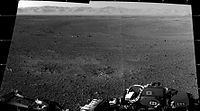
The rover has two pairs of black and whitenavigation camerasmounted on the mast to support ground navigation.[106][107]The cameras have a 45°angle of viewand use visible light to capturestereoscopic 3-D imagery.[107][108]
Rover Environmental Monitoring Station (REMS)[edit]
REMS comprises instruments to measure the Mars environment: humidity, pressure, temperatures, wind speeds, and ultraviolet radiation.[109]It is a meteorological package that includes anultravioletsensor provided by theSpanish Ministry of Education and Science.The investigative team is led by Javier Gómez-Elvira of theSpanish Astrobiology Centerand includes theFinnish Meteorological Instituteas a partner.[110][111]All sensors are located around three elements: two booms attached to the rover's mast, the Ultraviolet Sensor (UVS) assembly located on the rover top deck, and the Instrument Control Unit (ICU) inside the rover body. REMS provides new clues about the Martian general circulation, micro scale weather systems, local hydrological cycle, destructive potential of UV radiation, and subsurface habitability based on ground-atmosphere interaction.[110]
Hazard avoidance cameras (HazCams)[edit]
The rover has four pairs of black and white navigation cameras calledhazcams,two pairs in the front and two pairs in the back.[106][112]They are used for autonomous hazard avoidance during rover drives and for safe positioning of the robotic arm on rocks and soils.[112]Each camera in a pair is hardlinked to one of two identical main computers for redundancy; only four out of the eight cameras are in use at any one time. The cameras use visible light to capturestereoscopicthree-dimensional (3-D) imagery.[112]The cameras have a 120°field of viewand map the terrain at up to 3 m (9.8 ft) in front of the rover.[112]This imagery safeguards against the rover crashing into unexpected obstacles, and works in tandem with software that allows the rover to make its own safety choices.[112]
Mars Hand Lens Imager (MAHLI)[edit]
MAHLI is a camera on the rover's robotic arm, and acquires microscopic images of rock and soil. MAHLI can taketrue-colorimages at 1600×1200pixelswith a resolution as high as 14.5µmper pixel. MAHLI has an 18.3 to 21.3 mm (0.72 to 0.84 in) focal length and a 33.8–38.5° field of view.[87]MAHLI has both white and ultravioletLight-emitting diode(LED) illumination for imaging in darkness orfluorescenceimaging. MAHLI also has mechanical focusing in a range from infinite to millimeter distances.[87]This system can make some images withfocus stackingprocessing.[113]MAHLI can store either the raw images or do real time lossless predictive or JPEG compression. The calibration target for MAHLI includes color references, a metric bar graphic, a 1909 VDB Lincoln penny, and a stair-step pattern for depth calibration.[114]
Alpha Particle X-ray Spectrometer (APXS)[edit]
The APXS instrument irradiates samples withalpha particlesand maps the spectra ofX-raysthat are re-emitted for determining the elemental composition of samples.[115]Curiosity'sAPXS was developed by theCanadian Space Agency(CSA).[115]MacDonald Dettwiler (MDA),the Canadian aerospace company that built theCanadarmandRADARSAT,were responsible for the engineering design and building of the APXS. The APXS science team includes members from theUniversity of Guelph,theUniversity of New Brunswick,theUniversity of Western Ontario,NASA,theUniversity of California, San DiegoandCornell University.[116]The APXS instrument takes advantage ofparticle-induced X-ray emission(PIXE) andX-ray fluorescence,previously exploited by theMars Pathfinderand the twoMars Exploration Rovers.[115][117]
Chemistry and Mineralogy (CheMin)[edit]
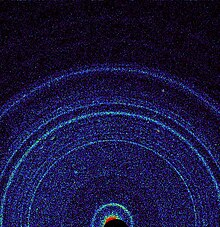
CheMinis the Chemistry and MineralogyX-raypowder diffractionandfluorescenceinstrument.[119]CheMin is one of fourspectrometers.It can identify and quantify the abundance of the minerals on Mars. It was developed by David Blake at NASAAmes Research Centerand theJet Propulsion Laboratory,[120]and won the 2013 NASA Government Invention of the year award.[121]The rover can drill samples from rocks and the resulting fine powder is poured into the instrument via a sample inlet tube on the top of the vehicle. A beam of X-rays is then directed at the powder and the crystal structure of the minerals deflects it at characteristic angles, allowing scientists to identify the minerals being analyzed.[122]
On October 17, 2012, at "Rocknest",the firstX-ray diffraction analysisofMartian soilwas performed. The results revealed the presence of several minerals, includingfeldspar,pyroxenesandolivine,and suggested that the Martian soil in the sample was similar to the "weatheredbasaltic soils"ofHawaiian volcanoes.[118]The paragonetictephrafrom a Hawaiiancinder conehas been mined to createMartian regolith simulantfor researchers to use since 1998.[123][124]
Sample Analysis at Mars (SAM)[edit]
The SAM instrument suite analyzesorganicsand gases from both atmospheric and solid samples. It consists of instruments developed by the NASAGoddard Space Flight Center,the NASAJet Propulsion LaboratorytheLaboratoire atmosphères, milieux, observations spatiales(LATMOS), theLaboratoire Inter-Universitaire des Systèmes Atmosphériques(LISA) (jointly operated by France'sCNRSand Parisian universities), andHoneybee Robotics,along with many additional external partners.[83][125][126]The three main instruments are aQuadrupole Mass Spectrometer(QMS), agas chromatograph(GC) and atunable laser spectrometer (TLS).These instruments perform precision measurements ofoxygenandcarbonisotoperatios incarbon dioxide(CO2) andmethane(CH4) in theatmosphere of Marsin order to distinguish between theirgeochemicalorbiologicalorigin.[83][126][127][128]
Dust Removal Tool (DRT)[edit]
The Dust Removal Tool (DRT) is a motorized, wire-bristle brush on the turret at the end ofCuriosity'sarm. The DRT was first used on a rock target namedEkwir_1on January 6, 2013.Honeybee Roboticsbuilt the DRT.[129]
Radiation assessment detector (RAD)[edit]
The role of theRadiation assessment detector(RAD) instrument is to characterize the broad spectrum of radiation environment found inside the spacecraft during the cruise phase and while on Mars. These measurements have never been done before from the inside of a spacecraft in interplanetary space. Its primary purpose is to determine the viability and shielding needs for potential human explorers, as well as to characterize the radiation environment on the surface of Mars, which it started doing immediately after MSL landed in August 2012.[130]Funded by the Exploration Systems Mission Directorate atNASA Headquartersand Germany's Space Agency (DLR), RAD was developed bySouthwest Research Institute(SwRI) and the extraterrestrial physics group atChristian-Albrechts-Universität zu Kiel,Germany.[130][131]
Dynamic Albedo of Neutrons (DAN)[edit]
The DAN instrument employs aneutron sourceand detector for measuring the quantity and depth ofhydrogenor ice and water at or near the Martian surface.[132] The instrument consists of the detector element (DE) and a 14.1 MeV pulsing neutron generator (PNG). The die-away time of neutrons is measured by the DE after each neutron pulse from the PNG. DAN was provided by theRussian Federal Space Agency[133][134]and funded by Russia.[135]
Mars Descent Imager (MARDI)[edit]
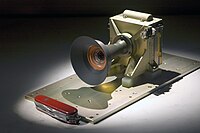
MARDI is fixed to the lower front left corner of the body ofCuriosity.During the descent to the Martian surface, MARDI took color images at 1600×1200 pixels with a 1.3-millisecond exposure time starting at distances of about 3.7 km (2.3 mi) to near 5 m (16 ft) from the ground, at a rate of fourframes per secondfor about two minutes.[88][136]MARDI has a pixel scale of 1.5 m (4 ft 11 in) at 2 km (1.2 mi) to 1.5 mm (0.059 in) at 2 m (6 ft 7 in) and has a 90° circular field of view. MARDI has eight gigabytes of internal buffer memory that is capable of storing over 4,000 raw images. MARDI imaging allowed the mapping of surrounding terrain and the location of landing.[88]JunoCam,built for theJunospacecraft,is based on MARDI.[137]
Robotic arm[edit]
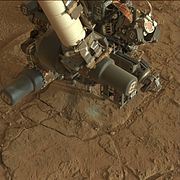
The rover has a 2.1 m (6 ft 11 in) longrobotic armwith a cross-shaped turret holding five devices that can spin through a 350° turning range.[139][140]The arm makes use of three joints to extend it forward and to stow it again while driving. It has a mass of 30 kg (66 lb) and its diameter, including the tools mounted on it, is about 60 cm (24 in).[141]It was designed, built, and tested byMDA US Systems,building upon their prior robotic arm work on theMars Surveyor 2001 Lander,thePhoenixlander, and the twoMars Exploration Rovers,SpiritandOpportunity.[142]
Two of the five devices arein-situor contact instruments known as theX-ray spectrometer(APXS), and theMars Hand Lens Imager(MAHLI camera). The remaining three are associated with sample acquisition and sample preparation functions: apercussion drill;a brush; and mechanisms for scooping, sieving, and portioning samples of powdered rock and soil.[139][141]The diameter of the hole in a rock after drilling is 1.6 cm (0.63 in) and up to 5 cm (2.0 in) deep.[140][143]The drill carries two spare bits.[143][144]The rover's arm and turret system can place the APXS and MAHLI on their respective targets, and also obtain powdered sample from rock interiors, and deliver them to theSAMandCheMinanalyzers inside the rover.[140]
Since early 2015 the percussive mechanism in the drill that helps chisel into rock has had an intermittent electrical short.[145]On December 1, 2016, the motor inside the drill caused a malfunction that prevented the rover from moving its robotic arm and driving to another location.[146]The fault was isolated to the drill feed brake,[147]and internal debris is suspected of causing the problem.[145]By December 9, 2016, driving and robotic arm operations were cleared to continue, but drilling remained suspended indefinitely.[148]TheCuriosityteam continued to perform diagnostics and testing on the drill mechanism throughout 2017,[149]and resumed drilling operations on May 22, 2018.[150]
Media, cultural impact and legacy[edit]
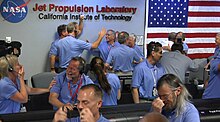
Live video showing the first footage from the surface of Mars was available atNASA TV,during the late hours of August 6, 2012, PDT, including interviews with the mission team. The NASA website momentarily became unavailable from the overwhelming number of people visiting it,[151]and a 13-minute NASA excerpt of the landings on its YouTube channel was halted an hour after the landing by an automatedcopyrighttakedown notice fromScripps Local News,which prevented access for several hours.[152]Around 1,000 people gathered in New York City'sTimes Square,to watch NASA's live broadcast ofCuriosity'slanding, as footage was being shown on the giant screen.[153]Bobak Ferdowsi,Flight Director for the landing, became anInternet memeand attained Twitter celebrity status, with 45,000 new followers subscribing to his Twitter account, due to hisMohawk hairstylewith yellow stars that he wore during the televised broadcast.[154][155]
On August 13, 2012, U.S. PresidentBarack Obama,calling from aboardAir Force Oneto congratulate theCuriosityteam, said, "You guys are examples of American know-how and ingenuity. It's really an amazing accomplishment".[156](Video (07:20))
Scientists at theGetty Conservation Institutein Los Angeles, California, viewed the CheMin instrument aboardCuriosityas a potentially valuable means to examine ancient works of art without damaging them. Until recently, only a few instruments were available to determine the composition without cutting out physical samples large enough to potentially damage the artifacts. CheMin directs a beam ofX-raysat particles as small as 400 μm (0.016 in)[157]and reads theradiationscatteredback to determine the composition of the artifact in minutes. Engineers created a smaller, portable version named theX-Duetto.Fitting into a fewbriefcase-sized boxes, it can examine objects on site, while preserving their physical integrity. It is now being used by Getty scientists to analyze a large collection of museumantiquesand the Roman ruins ofHerculaneum,Italy.[158]
Prior to the landing, NASA andMicrosoftreleasedMars Rover Landing,a free downloadable game onXbox Livethat usesKinectto capture body motions, which allows users to simulate the landing sequence.[159]
NASA gave the general public the opportunity from 2009 until 2011 to submit their names to be sent to Mars. More than 1.2 million people from the international community participated, and their names were etched intosiliconusing an electron-beam machine used for fabricating micro devices atJPL,and this plaque is now installed on the deck ofCuriosity.[160]In keeping with a 40-year tradition, a plaque with the signatures of President Barack Obama andVice President Joe Bidenwas also installed. Elsewhere on the rover is theautographof Clara Ma, the 12-year-old girl fromKansaswho gaveCuriosityits name in an essay contest, writing in part that "curiosity is the passion that drives us through our everyday lives".[161]
On August 6, 2013,Curiosityaudibly played "Happy Birthday to You"in honor of the one Earth year mark of its Martian landing, the first time for a song to be played on another planet. This was also the first time music was transmitted between two planets.[162]
On June 24, 2014,Curiositycompleted aMartian year— 687 Earth days — after finding that Mars once hadenvironmental conditions favorable for microbial life.[163]Curiosityserved as the basis for the design of thePerseverance roverfor theMars 2020 rover mission.Some spare parts from the build and ground test ofCuriosityare being used in the new vehicle, but it will carry a different instrument payload.[164]
In 2014, project chief engineer wrote a book detailing the development of the Curiosity rover. "Mars Rover Curiosity: An Inside Account from Curiosity's Chief Engineer, is a first hand account of the development and landing of the Curiosity Rover.[165]
On August 5, 2017, NASA celebrated the fifth anniversary of theCuriosityrover mission landing, and related exploratory accomplishments, on the planetMars.[11][12](Videos:Curiosity'sFirst Five Years (02:07);Curiosity'sPOV: Five Years Driving (05:49);Curiosity'sDiscoveries About Gale Crater (02:54))
As reported in 2018, drill samples taken in 2015 uncovered organic molecules ofbenzeneandpropanein 3 billion year old rock samples in Gale.[166][167][168]
Images[edit]
Components ofCuriosity[edit]
-
Mast head with ChemCam, MastCam-34, MastCam-100, NavCam
-
One of the six wheels onCuriosity
-
High-gain (right) and low-gain (left) antennas
-
UV sensor
Orbital images[edit]
-
Gale crater - surface materials (false colors;THEMIS;2001 Mars Odyssey).
-
Mount Sharprises from the middle of Gale; the green dot marksCuriosity'slanding site (north is down).
-
Curiosity'slanding ellipse.Quad 51, called Yellowknife, marks the area whereCuriosityactually landed.
-
Quad 51, a 1-mile-by-1-mile section of the crater Gale -Curiositylanding site is noted.
Rover images[edit]
-
Ejected heat shield as viewed byCuriositydescending to Martian surface (6 August 2012)
-
Curiosity'sfirst image after landing (6 August 2012). The rover's wheel can be seen.
-
Curiosity'sfirst image after landing (without clear dust cover, 6 August 2012)
-
Curiositylanded on 6 August 2012 near the base ofAeolis Mons(or "Mount Sharp" )[169]
-
Curiosity'sfirst color image of the Martian landscape, taken byMAHLI(6 August 2012)
-
Curiosity'sself-portrait – with closed dust cover (7 September 2012)
-
Curiosity'sself-portrait (7 September 2012; color-corrected)
-
U.S. Lincoln pennyonMars(Curiosity;4 September 2018)
-
Curiosity'stracks on first test drive (22 August 2012), after parking 6 m (20 ft) fromoriginal landing site[6]
-
Comparison ofcolor versions(raw, natural, white balance) ofAeolis Monson Mars (23 August 2012)
-
Layers at the base ofAeolis Mons.The dark rock in inset is the same size asCuriosity.
Self-portraits[edit]
(October 2012)
(May 2013)
(May 2014)
(January 2015)
(August 2015)
(October 2015)
(January 2016)
(September 2016)
(January 2018)
(June 2018)
(January 2019)
(May 2019)
(October 2019)
(November 2020)
(March 2021)
(November 2021)
Wide images[edit]
Locations[edit]


See also[edit]
- Experience Curiosity– Interactive web application
- InSight– Mars lander, arrived November 2018
- Life on Mars– Scientific assessments on the microbial habitability of Mars
- Viking program– Pair of NASA landers and orbiters sent to Mars in 1976
- Timeline of Mars Science Laboratory– Event timeline of the NASA Mars Science Laboratory mission
- Mars Express
- 2001 Mars Odyssey
- Mars Orbiter Mission– Indian space probe, launched in 2013
- Mars Reconnaissance Orbiter
- Mars 2020– Astrobiology Mars rover mission by NASA
- Sojournerrover
- Spiritrover
- Opportunityrover
- Perseverancerover
- Rosalind Franklinrover
- Zhurongrover
- Comparison of embedded computer systems on board the Mars rovers
References[edit]
- ^"Where Is Curiosity?".science.nasa.gov.NASA.RetrievedJune 24,2024.
 This article incorporates text from this source, which is in thepublic domain.
This article incorporates text from this source, which is in thepublic domain.
- ^Nelson, Jon."Mars Science Laboratory Curiosity Rover".NASA.RetrievedFebruary 2,2014.
- ^Abilleira, Fernando (2013).2011 Mars Science Laboratory Trajectory Reconstruction and Performance from Launch Through Landing.23rd AAS/AIAA Spaceflight Mechanics Meeting. February 10–14, 2013. Kauai, Hawaii.
- ^Amos, Jonathan (August 8, 2012)."Nasa's Curiosity rover lifts its navigation cameras".BBC News.RetrievedJune 23,2014.
- ^"MSL Sol 3 Update".NASA Television. August 8, 2012.RetrievedAugust 9,2012.
- ^abcBrown, Dwayne; Cole, Steve; Webster, Guy; Agle, D.C. (August 22, 2012)."NASA Mars Rover Begins Driving at Bradbury Landing".NASA.Archived fromthe originalon November 15, 2016.RetrievedAugust 22,2012.
- ^abHanna, Jason (August 10, 2012)."Impressive' Curiosity landing only 1.5 miles off, NASA says".CNN.RetrievedAugust 10,2012.
- ^ab"Overview".JPL, NASA.RetrievedAugust 16,2012.
- ^abc"Mars Science Laboratory: Mission Science Goals".NASA.August 2012.RetrievedFebruary 17,2021.
- ^"Curiosity's mission extended indefinitely".Newshub.December 5, 2012.RetrievedFebruary 17,2021.
- ^abWebster, Guy; Cantillo, Laurie; Brown, Dwayne (August 2, 2017)."Five Years Ago and 154 Million Miles Away: Touchdown!".NASA.RetrievedAugust 8,2017.
- ^abWall, Mike (August 5, 2017)."After 5 Years on Mars, NASA's Curiosity Rover Is Still Making Big Discoveries".Space.com.RetrievedAugust 8,2017.
- ^Chang, Ailsa(August 6, 2022)."What a decade of Curiosity has taught us about life on Mars".NPR.RetrievedAugust 6,2022.
- ^Bosco, Cassandro (March 12, 2013)."NASA/JPL Mars Curiosity Project Team Receive 2012 Robert J. Collier Trophy"(PDF).National Aeronautic Association.Archived fromthe original(PDF)on February 23, 2014.RetrievedFebruary 9,2014.
- ^"MSL Objectives".NASA.
- ^Phillips, Tony (February 24, 2012)."Curiosity, The Stunt Double".NASA.Archived fromthe originalon August 1, 2012.RetrievedJanuary 26,2014.
- ^Grotzinger, John P. (January 24, 2014)."Habitability, Taphonomy, and the Search for Organic Carbon on Mars".Science.343(6169): 386–387.Bibcode:2014Sci...343..386G.doi:10.1126/science.1249944.PMID24458635.
- ^"PIA16068".NASA. Archived fromthe originalon November 29, 2014.RetrievedAugust 17,2012.
- ^abBrown, Dwayne C.; Buis, Alan; Martinez, Carolina (May 27, 2009)."NASA Selects Student's Entry as New Mars Rover Name".NASA / Jet Propulsion Laboratory. Archived fromthe originalon April 30, 2019.RetrievedJanuary 2,2017.
 This article incorporates text from this source, which is in thepublic domain.
This article incorporates text from this source, which is in thepublic domain.
- ^Dreier, Casey (July 29, 2020)."The Cost of Perseverance, in Context".The Planetary Society.
- ^ab"MSL at a glance".CNES.RetrievedAugust 7,2012.
- ^abWatson, Traci (April 14, 2008)."Troubles parallel ambitions in NASA Mars project".USA Today.RetrievedMay 27,2009.
- ^Mars Rovers: Pathfinder, MER (Spirit and Opportunity), and MSL(video). Pasadena, California. April 12, 2008.RetrievedSeptember 22,2011.
- ^"Mars Exploration Rover Launches"(PDF).NASA. June 2003.Archived(PDF)from the original on July 26, 2004.
- ^abc"Mars Science Laboratory (MSL): Mast Camera (MastCam): Instrument Description".Malin Space Science Systems.RetrievedApril 19,2009.
- ^abc"Mars Science Laboratory - Facts"(PDF).Jet Propulsion Laboratory, NASA. March 2012. Archived fromthe original(PDF)on August 8, 2012.RetrievedJuly 31,2012.
- ^abcdefghiMakovsky, Andre; Ilott, Peter; Taylor, Jim (November 2009).Mars Science Laboratory Telecommunications System Design(PDF).DESCANSO Design and Performance Summary Series. Vol. 14. NASA/Jet Propulsion Laboratory.
- ^abc"Multi-Mission Radioisotope Thermoelectric Generator (MMRTG)"(PDF).NASA/JPL. October 2013.Archived(PDF)from the original on February 26, 2015.RetrievedFebruary 17,2021.
- ^abc"Mars Exploration: Radioisotope Power and Heating for Mars Surface Exploration"(PDF).NASA/JPL. April 18, 2006. Archived fromthe original(PDF)on October 12, 2012.RetrievedSeptember 7,2009.
- ^Clark, Stephen (November 17, 2011)."Nuclear power generator hooked up to Mars rover".Spaceflight Now.RetrievedNovember 11,2013.
- ^Ritz, Fred; Peterson, Craig E. (2004)."Multi-Mission Radioisotope Thermoelectric Generator (MMRTG) Program Overview"(PDF).2004 IEEE Aerospace Conference Proceedings (IEEE Cat. No.04TH8720).2004 IEEE Aerospace Conference. March 6–13, 2004. Big Sky, Montana. pp. 2950–2957.doi:10.1109/AERO.2004.1368101.ISBN0-7803-8155-6.Archived fromthe original(PDF)on December 16, 2011.
- ^Campbell, Joseph (2011)."Fueling the Mars Science Laboratory"(PDF).Idaho National Laboratory. Archived fromthe original(PDF)on March 4, 2016.RetrievedFebruary 28,2016.
- ^"Technologies of Broad Benefit: Power".NASA/JPL.Archived fromthe originalon June 14, 2008.RetrievedSeptember 20,2008.
- ^"Mars Science Laboratory – Technologies of Broad Benefit: Power".NASA/JPL.RetrievedApril 23,2011.
- ^Misra, Ajay K. (June 26, 2006)."Overview of NASA Program on Development of Radioisotope Power Systems with High Specific Power"(PDF).NASA/JPL. Archived fromthe original(PDF)on August 9, 2012.RetrievedMay 12,2009.
- ^abWatanabe, Susan (August 9, 2009)."Keeping it Cool (...or Warm!)".NASA/JPL.RetrievedFebruary 17,2021.
- ^abcde"Mars Science Laboratory: Mission: Rover: Brains".NASA/JPL.RetrievedMarch 27,2009.
- ^Bajracharya, Max; Maimone, Mark W.; Helmick, Daniel (December 2008). "Autonomy for Mars rovers: past, present, and future".Computer.41(12): 45.doi:10.1109/MC.2008.515.ISSN0018-9162.
- ^"BAE Systems Computers to Manage Data Processing and Command For Upcoming Satellite Missions"(Press release). SpaceDaily. June 17, 2008.
- ^"E&ISNow — Media gets closer look at Manassas"(PDF).BAE Systems. August 1, 2008. Archived fromthe original(PDF)on December 17, 2008.RetrievedNovember 17,2008.
- ^"RAD750 radiation-hardened PowerPC microprocessor".BAE Systems. July 1, 2008. Archived fromthe original(PDF)on December 24, 2013.RetrievedSeptember 7,2009.
- ^"RAD6000 Space Computers"(PDF).BAE Systems. June 23, 2008. Archived fromthe original(PDF)on October 4, 2009.RetrievedSeptember 7,2009.
- ^Webster, Guy (March 4, 2013)."Curiosity Rover's Recovery on Track".NASA.Archived fromthe originalon June 17, 2019.RetrievedMarch 5,2013.
- ^Webster, Guy (March 25, 2013)."Curiosity Resumes Science Investigations".NASA.Archived fromthe originalon June 2, 2019.RetrievedMarch 27,2013.
- ^Gaudin, Sharon (August 8, 2012)."NASA: Your smartphone is as smart as the Curiosity rover".Computerworld.Archived fromthe originalon June 17, 2018.RetrievedJune 17,2018.
- ^"Mars-Earth distance in light minutes".WolframAlpha.RetrievedAugust 6,2012.
- ^"Curiosity's data communication with Earth".NASA.RetrievedAugust 7,2012.
- ^"NASA's Curiosity Rover Maximizes Data Sent to Earth by Using International Space Data Communication Standards"(PDF).RetrievedFebruary 17,2021.
- ^"ESA spacecraft records crucial NASA signals from Mars".Mars Daily.August 7, 2012.RetrievedAugust 8,2012.
- ^NASA Mars exploration efforts turn to operating existing missions and planning sample return.Jeff Foust,Space News.February 23, 2018.
- ^"Next Mars Rover Sports a Set of New Wheels".NASA/JPL. July 2010. Archived fromthe originalon July 5, 2014.RetrievedAugust 6,2012.
- ^"Watch NASA's Next Mars Rover Being Built Via Live 'Curiosity Cam'".NASA.September 13, 2011. Archived fromthe originalon November 26, 2011.RetrievedAugust 16,2012.
- ^"New Mars Rover to Feature Morse Code".National Association for Amateur Radio.March 29, 2011.
- ^Marlow, Jeffrey (August 29, 2012)."Looking Toward the Open Road".JPL - Martian Diaries.NASA.RetrievedAugust 30,2012.
- ^Lakdawalla, Emily (August 19, 2014)."Curiosity wheel damage: The problem and solutions".The Planetary Society Blogs.The Planetary Society.RetrievedAugust 22,2014.
- ^"First drive".
- ^Gorman, Steve (August 8, 2011)."Curiosity beams Mars images back".Stuff - Science.RetrievedAugust 8,2012.
- ^ab"Mars Science Laboratory".NASA. Archived fromthe originalon July 30, 2009.RetrievedAugust 6,2012.
- ^"Vandi Verma".ResearchGate.RetrievedFebruary 7,2019.
- ^"Dr. Vandi Verma Group Supervisor".Jet Propulsion Laboratory.CIT. Archived fromthe originalon April 14, 2009.RetrievedFebruary 8,2019.
- ^Estlin, Tara; Jonsson, Ari;Pasareanu, Corina;Simmons, Reid; Tso, Kam; Verma, Vandi (April 2006)."Plan Execution Interchange Language (PLEXIL)"(PDF).NASA Technical Reports Server.NASA.RetrievedFebruary 8,2019.
 This article incorporates text from this source, which is in thepublic domain.
This article incorporates text from this source, which is in thepublic domain.
- ^"Bibliography of PLEXIL-related publications, organized by category".plexil,souceforge.RetrievedFebruary 8,2019.
- ^"Main page: NASA applications".plexil.sourceforge.RetrievedFebruary 8,2019.
- ^"Curiosity's Quad - IMAGE".NASA.August 10, 2012.RetrievedAugust 11,2012.
- ^Agle, DC; Webster, Guy; Brown, Dwayne (August 9, 2012)."NASA's Curiosity Beams Back a Color 360 of Gale Crate".NASA.Archived fromthe originalon June 2, 2019.RetrievedAugust 11,2012.
- ^Amos, Jonathan (August 9, 2012)."Mars rover makes first colour panorama".BBC News.RetrievedAugust 9,2012.
- ^Halvorson, Todd (August 9, 2012)."Quad 51: Name of Mars base evokes rich parallels on Earth".USA Today.RetrievedAugust 12,2012.
- ^"Video from rover looks down on Mars during landing".MSNBC.August 6, 2012.RetrievedOctober 7,2012.
- ^Young, Monica (August 7, 2012)."Watch Curiosity Descend onto Mars".Sky & Telescope.SkyandTelescope.com.RetrievedOctober 7,2012.
- ^Hand, Eric (August 3, 2012)."Crater mound a prize and puzzle for Mars rover".Nature.doi:10.1038/nature.2012.11122.S2CID211728989.RetrievedAugust 6,2012.
- ^"Gale Crater's History Book".Mars Odyssey THEMIS.RetrievedAugust 6,2012.
- ^Chang, Kenneth (October 5, 2015)."Mars Is Pretty Clean. Her Job at NASA Is to Keep It That Way".The New York Times.RetrievedOctober 6,2015.
- ^"Why NASA's Mars Curiosity Rover landing will be" Seven Minutes of Absolute Terror "".NASA.Centre National d'Etudes Spatiales (CNES). June 28, 2012.RetrievedJuly 13,2012.
- ^"Final Minutes of Curiosity's Arrival at Mars".NASA/JPL.RetrievedApril 8,2011.
- ^Teitel, Amy Shira (November 28, 2011)."Sky Crane – how to land Curiosity on the surface of Mars".Scientific American.RetrievedAugust 6,2012.
- ^Snider, Mike (July 17, 2012)."Mars rover lands on Xbox Live".USA Today.RetrievedJuly 27,2012.
- ^"Mars Science Laboratory: Entry, Descent, and Landing System Performance"(PDF).NASA.March 2006. p. 7.
- ^Amos, Jonathan (June 12, 2012)."NASA's Curiosity rover targets smaller landing zone".BBC News.RetrievedJune 12,2012.
- ^"MSL Notebook - Curiosity Mars Rover data".an.rsl.wustl.edu.RetrievedDecember 9,2020.
- ^Amanda Kooser (September 5, 2020)."NASA's Perseverance Mars rover has an Earth twin named Optimism".C/Net.
- ^Jet Propulsion Laboratory (JPL) (September 4, 2020)."NASA Readies Perseverance Mars Rover's Earthly Twin".Mars Exploration Program.NASA.
- ^Amos, Jonathan (August 3, 2012)."Gale Crater: Geological 'sweet shop' awaits Mars rover".BBC News.RetrievedAugust 6,2012.
- ^abc"MSL Science Corner: Sample Analysis at Mars (SAM)".NASA/JPL. Archived fromthe originalon March 20, 2009.RetrievedSeptember 9,2009.
- ^"Overview of the SAM instrument suite".NASA. Archived fromthe originalon February 22, 2007.
- ^Malin, M. C.; Bell, J. F.; Cameron, J.; Dietrich, W. E.; Edgett, K. S.; et al. (2005).The Mast Cameras and Mars Descent Imager (MARDI) for the 2009 Mars Science Laboratory(PDF).Lunar and Planetary Science XXXVI. p. 1214.Bibcode:2005LPI....36.1214M.
- ^abcde"Mast Camera (MastCam)".NASA/JPL. Archived fromthe originalon February 18, 2009.RetrievedMarch 18,2009.
- ^abc"Mars Hand Lens Imager (MAHLI)".NASA/JPL. Archived fromthe originalon March 20, 2009.RetrievedMarch 23,2009.
- ^abc"Mars Descent Imager (MARDI)".NASA/JPL. Archived fromthe originalon March 20, 2009.RetrievedApril 3,2009.
- ^Stern, Alan; Green, Jim (November 8, 2007)."Mars Science Laboratory Instrumentation Announcement from Alan Stern and Jim Green, NASA Headquarters".SpaceRef.com.RetrievedAugust 6,2012.[permanent dead link]
- ^Mann, Adam (August 7, 2012)."The Photo-Geek's Guide to Curiosity Rover's 17 Cameras".Wired.RetrievedJanuary 16,2015.
- ^Klinger, Dave (August 7, 2012)."Curiosity says good morning from Mars (and has busy days ahead)".Ars Technica.RetrievedJanuary 16,2015.
- ^"Mars Science Laboratory (MSL) Mast Camera (MastCam)".Malin Space Science Systems.RetrievedAugust 6,2012.
- ^David, Leonard (March 28, 2011)."NASA Nixes 3-D Camera for Next Mars Rover".Space.com.RetrievedAugust 6,2012.
- ^Bell III, J. F.; Maki, J. N.; Mehall, G. L.; Ravine, M. A.; Caplinger, M. A. (2014).Mastcam-Z: A Geologic, Stereoscopic, and Multispectral Investigation on the NASA Mars-2020 Rover(PDF).International Workshop on Instrumentation for Planetary Missions, November 4–7, 2014, Greenbelt, Maryland. NASA. Archived fromthe original(PDF)on September 26, 2015.
 This article incorporates text from this source, which is in thepublic domain.
This article incorporates text from this source, which is in thepublic domain.
- ^abcd"MSL Science Corner: Chemistry & Camera (ChemCam)".NASA/JPL. Archived fromthe originalon March 20, 2009.RetrievedSeptember 9,2009.
- ^Salle, B.; Lacour, J. L.; Mauchien, P.; Fichet, P.; Maurice, S.; et al. (2006)."Comparative study of different methodologies for quantitative rock analysis by Laser-Induced Breakdown Spectroscopy in a simulated Martian atmosphere"(PDF).Spectrochimica Acta Part B: Atomic Spectroscopy.61(3): 301–313.Bibcode:2006AcSpB..61..301S.doi:10.1016/j.sab.2006.02.003.
- ^Wiens, R.C.; Maurice, S.; Engel, A; Fabry, V. J.; Hutchins, D. A.; et al. (2008)."Corrections and Clarifications, News of the Week".Science.322(5907): 1466.doi:10.1126/science.322.5907.1466a.PMC1240923.
- ^"ChemCam Status".Los Alamos National Laboratory. April 2008. Archived fromthe originalon November 9, 2013.RetrievedAugust 6,2012.
- ^"Spacecraft: Surface Operations Configuration: Science Instruments: ChemCam".Archived fromthe originalon October 2, 2006.
- ^Vieru, Tudor (December 6, 2013)."Curiosity's Laser Reaches 100,000 Firings on Mars".Softpedia.RetrievedJanuary 16,2015.
- ^"Rover's Laser Instrument Zaps First Martian Rock".2012.RetrievedFebruary 17,2021.
- ^Webster, Guy; Agle, D.C. (August 19, 2012)."Mars Science Laboratory/Curiosity Mission Status Report".NASA.RetrievedSeptember 3,2012.
- ^"'Coronation' Rock on Mars ".NASA.RetrievedSeptember 3,2012.
- ^Amos, Jonathan (August 17, 2012)."Nasa's Curiosity rover prepares to zap Martian rocks".BBC News.RetrievedSeptember 3,2012.
- ^"How Does ChemCam Work?".ChemCam Team.2011.RetrievedAugust 20,2012.
- ^ab"Mars Science Laboratory Rover in the JPL Mars Yard".NASA/JPL. Archived fromthe originalon May 10, 2009.RetrievedMay 10,2009.
- ^"First NavCam mosaic".
- ^Gómez-Elvira, J.; Haberle, B.; Harri, A.; Martinez-Frias, J.; Renno, N.; Ramos, M.; Richardson, M.; de la Torre, M.; Alves, J.; Armiens, C.; Gómez, F.; Lepinette, A.; Mora, L.; Martín, J.; Martín-Torres, J.; Navarro, S.; Peinado, V.; Rodríguez-Manfredi, J. A.; Romeral, J.; Sebastián, E.; Torres, J.; Zorzano, M. P.; Urquí, R.; Moreno, J.; Serrano, J.; Castañer, L.; Jiménez, V.; Genzer, M.; Polko, J. (February 2011)."Rover Environmental Monitoring Station for MSL mission"(PDF).4th International Workshop on the Mars Atmosphere: Modelling and Observations:473.Bibcode:2011mamo.conf..473G.RetrievedAugust 6,2012.
- ^ab"MSL Science Corner: Rover Environmental Monitoring Station (REMS)".NASA/JPL. Archived fromthe originalon March 20, 2009.RetrievedSeptember 9,2009.
- ^"Mars Science Laboratory Fact Sheet"(PDF).NASA/JPL.RetrievedJune 20,2011.
- ^abcde"Mars Science Laboratory: Mission: Rover: Eyes and Other Senses: Four Engineering Hazcams (Hazard Avoidance Cameras)".NASA/JPL.RetrievedApril 4,2009.
- ^Edgett, Kenneth S."Mars Hand Lens Imager (MAHLI)".NASA. Archived fromthe originalon March 20, 2009.RetrievedJanuary 11,2012.
- ^"3D View of MAHLI Calibration Target".NASA.September 13, 2012.RetrievedOctober 11,2012.
- ^abc"MSL Science Corner: Alpha Particle X-ray Spectrometer (APXS)".NASA/JPL. Archived fromthe originalon March 20, 2009.RetrievedSeptember 9,2009.
- ^"40th Lunar and Planetary Science Conference"(PDF).2009.
"41st Lunar and Planetary Science Conference"(PDF).2010. - ^Rieder, R.; Gellert, R.; Brückner, J.; Klingelhöfer, G.; Dreibus, G.; et al. (2003)."The new Athena alpha particle X-ray spectrometer for the Mars Exploration Rovers".Journal of Geophysical Research.108(E12): 8066.Bibcode:2003JGRE..108.8066R.doi:10.1029/2003JE002150.
- ^abBrown, Dwayne (October 30, 2012)."NASA Rover's First Soil Studies Help Fingerprint Martian Minerals".NASA.Archived fromthe originalon June 3, 2016.RetrievedOctober 31,2012.
- ^"MSL Chemistry & Mineralogy X-ray diffraction(CheMin)".NASA/JPL.RetrievedNovember 25,2011.
- ^Sarrazin, P.; Blake, D.; Feldman, S.; Chipera, S.; Vaniman, D.; et al. (2005). "Field deployment of a portable X-ray diffraction/X-ray fluorescence instrument on Mars analog terrain".Powder Diffraction.20(2): 128–133.Bibcode:2005PDiff..20..128S.doi:10.1154/1.1913719.S2CID122528094.
- ^Hoover, Rachel (June 24, 2014)."Ames Instrument Helps Identify the First Habitable Environment on Mars, Wins Invention Award".NASA.Archived fromthe originalon August 18, 2016.RetrievedJune 25,2014.
- ^Anderson, Robert C.; Baker, Charles J.; Barry, Robert; Blake, David F.; Conrad, Pamela; et al. (December 14, 2010)."Mars Science Laboratory Participating Scientists Program Proposal Information Package"(PDF).NASA/Jet Propulsion Laboratory.RetrievedJanuary 16,2015.
- ^Beegle, L. W.; Peters, G. H.; Mungas, G. S.; Bearman, G. H.; Smith, J. A.; et al. (2007)."Mojave Martian Simulant: A New Martian Soil Simulant"(PDF).Lunar and Planetary Science Conference(1338): 2005.Bibcode:2007LPI....38.2005B.RetrievedApril 28,2014.
- ^Allen, C. C.; Morris, R. V.; Lindstrom, D. J.; Lindstrom, M. M.; Lockwood, J. P. (March 1997).JSC Mars-1: Martian regolith simulant(PDF).Lunar and Planetary Exploration XXVIII. Archived fromthe original(PDF)on September 10, 2014.RetrievedApril 28,2014.
- ^Cabane, M.; Coll, P.; Szopa, C.; Israël, G.; Raulin, F.; et al. (2004)."Did life exist on Mars? Search for organic and inorganic signatures, one of the goals for" SAM "(sample analysis at Mars)"(PDF).Advances in Space Research.33(12): 2240–2245.Bibcode:2004AdSpR..33.2240C.doi:10.1016/S0273-1177(03)00523-4.
- ^ab"Sample Analysis at Mars (SAM) Instrument Suite".NASA.October 2008. Archived fromthe originalon October 7, 2008.RetrievedOctober 9,2009.
- ^Tarsitano, C. G.; Webster, C. R. (2007). "Multilaser Herriott cell for planetary tunable laser spectrometers".Applied Optics.46(28): 6923–6935.Bibcode:2007ApOpt..46.6923T.doi:10.1364/AO.46.006923.PMID17906720.
- ^Mahaffy, Paul R.; Webster, Christopher R.; Cabane, Michel; Conrad, Pamela G.; Coll, Patrice; et al. (2012)."The Sample Analysis at Mars Investigation and Instrument Suite".Space Science Reviews.170(1–4): 401–478.Bibcode:2012SSRv..170..401M.doi:10.1007/s11214-012-9879-z.S2CID3759945.
- ^Moskowitz, Clara (January 7, 2013)."NASA's Curiosity Rover Brushes Mars Rock Clean, a First".Space.com.RetrievedJanuary 16,2015.
- ^ab"SwRI Radiation Assessment Detector (RAD) Homepage".Southwest Research Institute.RetrievedJanuary 19,2011.
- ^"RAD".NASA.
- ^"Laboratory for Space Gamma Spectroscopy - DAN".Laboratory for Space Gamma Spectroscopy. Archived fromthe originalon May 21, 2013.RetrievedSeptember 20,2012.
- ^"MSL Science Corner: Dynamic Albedo of Neutrons (DAN)".NASA/JPL. Archived fromthe originalon March 20, 2009.RetrievedSeptember 9,2009.
- ^Litvak, M. L.; Mitrofanov, I. G.; Barmakov, Yu. N.; Behar, A.; Bitulev, A.; et al. (2008). "The Dynamic Albedo of Neutrons (DAN) Experiment for NASA's 2009 Mars Science Laboratory".Astrobiology.8(3): 605–12.Bibcode:2008AsBio...8..605L.doi:10.1089/ast.2007.0157.PMID18598140.
- ^"Mars Science Laboratory: Mission".NASA JPL.RetrievedAugust 6,2012.
- ^"Mars Descent Imager (MARDI) Update".Malin Space Science Systems. November 12, 2007. Archived fromthe originalon September 4, 2012.RetrievedAugust 6,2012.
- ^"Junocam, Juno Jupiter Orbiter".Malin Space Science Systems.RetrievedAugust 6,2012.
- ^Anderson, Paul Scott (February 3, 2013)."Curiosity 'hammers' a rock and completes first drilling tests".themeridianijournal.com. Archived fromthe originalon February 6, 2013.RetrievedFebruary 3,2013.
- ^ab"Curiosity Rover - Arm and Hand".JPL.NASA.RetrievedAugust 21,2012.
- ^abcJandura, Louise."Mars Science Laboratory Sample Acquisition, Sample Processing and Handling: Subsystem Design and Test Challenges"(PDF).JPL.NASA.RetrievedAugust 21,2012.
- ^ab"Curiosity Stretches its Arm".JPL.NASA. August 21, 2012. Archived fromthe originalon August 22, 2012.RetrievedAugust 21,2012.
- ^Billing, Rius; Fleischner, Richard.Mars Science Laboratory Robotic Arm(PDF)(Report). MDA US Systems. Archived fromthe original(PDF)on October 6, 2016.RetrievedJanuary 22,2017.
- ^ab"MSL Participating Scientists Program - Proposal Information Package"(PDF).Washington University. December 14, 2010.RetrievedAugust 21,2012.
- ^Billing, Rius; Fleischner, Richard (2011)."Mars Science Laboratory Robotic Arm"(PDF).15th European Space Mechanisms and Tribology Symposium 2011.RetrievedAugust 21,2012.
- ^abClark, Stephen (December 29, 2016)."Internal debris may be causing problem with Mars rover's drill".Spaceflight Now.RetrievedJanuary 22,2017.
- ^"NASA Is Trying to Get Mars Rover Curiosity's Arm Unstuck".Popular Mechanics. Associated Press. December 13, 2016.RetrievedJanuary 18,2017.
- ^Wall, Mike (December 15, 2016)."Drill Issue Continues to Afflict Mars Rover Curiosity".SPACE.com.RetrievedFebruary 10,2018.
- ^"Sols 1545-1547: Moving again!".NASA Mars Rover Curiosity: Mission Updates. NASA. December 9, 2016.
 This article incorporates text from this source, which is in thepublic domain.
This article incorporates text from this source, which is in thepublic domain.
- ^Lakdawalla, Emily (September 6, 2017)."Curiosity's balky drill: The problem and solutions".The Planetary Society.RetrievedFebruary 10,2018.
- ^Curiosity Rover is Drilling AgainDavid Dickinon,Sky and Telescope,June 4, 2018
- ^"Curiosity Lands on Mars".NASA TV.Archived fromthe originalon August 6, 2012.RetrievedAugust 6,2012.
- ^"NASA's Mars Rover Crashed Into a DMCA Takedown".Motherboard.Motherboard.vice.com. August 6, 2012. Archived fromthe originalon August 8, 2012.RetrievedAugust 8,2012.
- ^"Huge Crowds Watched NASA Rover Land on Mars from NYC's Times Square".Space.com.RetrievedAugust 8,2012.
- ^"Mars Rover 'Mohawk Guy' a Space Age Internet Sensation | Curiosity Rover".Space.com.August 7, 2012.RetrievedAugust 8,2012.
- ^"Mars landing proves memes now travel faster than the speed of light (gallery)".VentureBeat.June 18, 2012.RetrievedAugust 8,2012.
- ^Chang, Kenneth (August 13, 2012)."Mars Looks Quite Familiar, if Only on the Surface".The New York Times.RetrievedAugust 14,2012.
- ^Boyer, Brad (March 10, 2011)."inXitu co-founder wins NASA Invention of the Year Award for 2010"(PDF)(Press release).InXitu.Archived fromthe original(PDF)on August 3, 2012.RetrievedAugust 13,2012.
- ^"Martian rover tech has an eye for priceless works of art".August 10, 2012.RetrievedAugust 13,2012.
- ^Thomen, Daryl (August 6, 2012)."'Mars Rover Landing' with Kinect for the Xbox 360 ".Newsday.RetrievedAugust 8,2012.
- ^"Send Your Name to Mars".NASA.2010. Archived fromthe originalon August 7, 2012.RetrievedAugust 7,2012.
- ^"NASA's Curiosity rover flying to Mars with Obama's, others' autographs on board".collectSPACE.RetrievedAugust 11,2012.
- ^Dewey, Caitlin (August 6, 2013)."Lonely Curiosity rover sings 'Happy Birthday' to itself on Mars".The Washington Post.RetrievedAugust 7,2013.
- ^Webster, Guy; Brown, Dwayne (June 23, 2014)."NASA's Mars Curiosity Rover Marks First Martian Year".NASA.RetrievedJune 23,2014.
- ^Harwood, William (December 4, 2012)."NASA announces plans for new $1.5 billion Mars rover".CNET.RetrievedDecember 5,2012.
Using spare parts and mission plans developed for NASA'sCuriosityMars rover, the space agency says it can build and launch a new rover in 2020 and stay within current budget guidelines.
- ^"Mars Rover Curiosity: An Inside Account from Curiosity'…".
- ^Chang, Kenneth (June 7, 2018)."Life on Mars? Rover's Latest Discovery Puts It" On the Table "".The New York Times.RetrievedJune 8,2018.
The identification of organic molecules in rocks on the red planet does not necessarily point to life there, past or present, but does indicate that some of the building blocks were present.
- ^Ten Kate, Inge Loes (June 8, 2018). "Organic molecules on Mars".Science.360(6393): 1068–1069.Bibcode:2018Sci...360.1068T.doi:10.1126/science.aat2662.PMID29880670.S2CID46952468.
- ^Eigenbrode, Jennifer L.;et al. (June 8, 2018)."Organic matter preserved in 3-billion-year-old mudstones at Gale crater, Mars"(PDF).Science.360(6393): 1096–1101.Bibcode:2018Sci...360.1096E.doi:10.1126/science.aas9185.hdl:10044/1/60810.PMID29880683.S2CID46983230.
- ^abWilliams, John (August 15, 2012)."A 360-degree 'street view' from Mars".PhysOrg.RetrievedAugust 16,2012.
- ^Bodrov, Andrew (September 14, 2012)."Mars Panorama - Curiosity rover: Martian solar day 2".360Cities.Archived fromthe originalon August 19, 2012.RetrievedSeptember 14,2012.
External links[edit]
- Curiosity- NASA's Mars Exploration Program
- The search for life on Mars and elsewhere in the Solar System:Curiosityupdate - Video lecture by Christopher P. McKay
- MSL -CuriosityDesign and Mars Landing - PBSNova(14 November 2012) - Video (53:06)
- MSL - "Curiosity'StreetView' "(Sol 2 - 8 August 2012) - NASA/JPL - 360° Panorama
- MSL -CuriosityRover - Learn AboutCuriosity- NASA/JPL
- MSL -CuriosityRover - Virtual Tour - NASA/JPL
- MSL - NASA Image GalleryArchivedJanuary 7, 2020, at theWayback Machine
- Weather Reportsfrom the Rover Environmental Monitoring Station (REMS)
- CuriosityonX
- MSL - NASA Update - AGU Conference (3 December 2012) Video (70:13)
- Panorama(via Universe Today)
- Curiosity's Proposed Path up Mount SharpNASA May 2019
- 2011 robots
- 2012 on Mars
- Aeolis quadrangle
- American inventions
- Astrobiology space missions
- Individual space vehicles
- Mars rovers
- Mars Science Laboratory
- NASA space probes
- Nuclear-powered robots
- Nuclear power in space
- Robots of the United States
- Six-wheeled robots
- Soft landings on Mars
- Space probes launched in 2011
- Mars robots

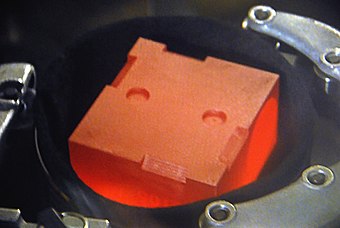



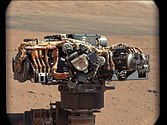
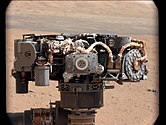
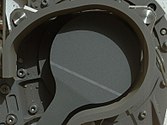
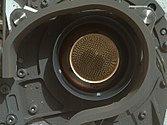






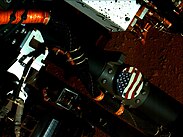
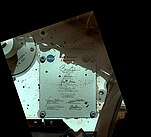
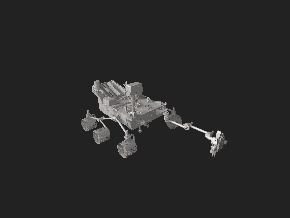




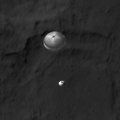












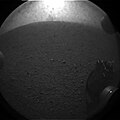

![Curiosity landed on 6 August 2012 near the base of Aeolis Mons (or "Mount Sharp")[169]](https://upload.wikimedia.org/wikipedia/commons/thumb/6/65/673885main_PIA15986-full_full.jpg/120px-673885main_PIA15986-full_full.jpg)

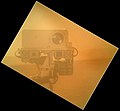





![Curiosity's tracks on first test drive (22 August 2012), after parking 6 m (20 ft) from original landing site[6]](https://upload.wikimedia.org/wikipedia/commons/thumb/6/63/PIA16094-Mars_Curiosity_Rover-First_Drive_Tracks.jpg/120px-PIA16094-Mars_Curiosity_Rover-First_Drive_Tracks.jpg)
























